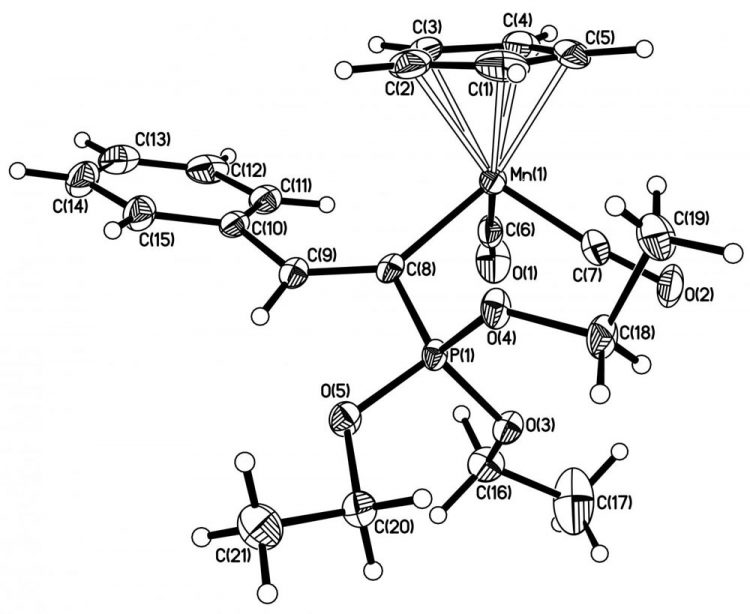RUDN chemists have discovered a new formation mechanism of anti-cancer substances

This is one of the cymantrene derivatives used in the study. Credit: Alexander Smol'yakov
RUDN University chemists revised the formation mechanism of organophosphorus complexes with metal. The results of the study may help in the production of organophosphorus compounds, polymers with specified properties as well as in the synthesis of anti-cancer drugs, as reported by Journal of Organometallic Chemistry.
The scientists are working on methods of creating substances with carbon-phosphorus chemical bonds, using organometallic compounds. The result of such reactions is formation of organophosphorus complexes that are biologically active organic molecules, containing phosphorus atoms in their structure. Stearyl phosphate complexes are of most interest, that are an important class of molecules (vinylphosphonates), widely used in organic chemistry.
Various organophosphorus compounds are synthesized of them, functionally substituted polymers with specified properties (for example, incombustible materials). The importance of new methods for the synthesis of vinylphosphonates is simple to explain: such substances are used extensively in cellular research and are promising for the development of anti-cancer drugs.
Recently, the scientists have been actively exploring rhenium (Re) metal complexes for their possible use as anti-cancer drugs. Organometallic complexes with CO ligands can be used as so-called CO-releasing molecules for the destruction of cancer cells. Organometallic complexes with rhenium are also used in infrared spectromicroscopy of cells.
The authors selected vinylidene complexes of manganese (Mn) and rhenium (Re) as starting materials, that joined trivalent phosphorus (trialkyl phosphites, phosphonites and phosphinites) in a combination reaction. The chemists supposed that the result would be styrylphosphonate complexes, but the mechanism of this transformation was not entirely clear.
“Having certain experience in the study of the interaction between vinylidene complexes of transition metals and organic phosphorus derivatives, we assumed that the mechanism of the chemical reaction that they proposed earlier does not correspond to reality and requires a more detailed investigation”, as noted by co-author of the study Alexander Smol'yakov.
The chemists determined the structure of the intermediate and final products of the reactions of manganese and rhenium vinylidene complexes and their derivatives using spectroscopic methods, and also selected the necessary conditions to perform the reaction for the isolation of intermediates in the form of single crystals for the purpose of studying them by X-ray diffraction (studying the atomic structure of a crystal using X-ray radiation).
As a result, it was found that the reaction does not proceed according to the Michaelis-Arbuzov reaction mechanism, as previously thought, but another way. The scientists proved that during synthesis of styrylphosphonate complexes some by-products form. Their decomposition in water leads to the formation of the desired compounds.
The transformations discovered by RUDN University scientists may be used to develop methods for preparation of vinylphosphonate derivatives from terminal alkynes (carbons with a triple bond at the ends of the molecule), which is important for the purposes of organic synthesis.
In the future, RUDN University scientists are going to expand the range of organometallic complexes they work with. This will allow a better understanding of the possibilities of multiple (not single) metal-carbon bonds complexes chemistry.
Media Contact
All latest news from the category: Life Sciences and Chemistry
Articles and reports from the Life Sciences and chemistry area deal with applied and basic research into modern biology, chemistry and human medicine.
Valuable information can be found on a range of life sciences fields including bacteriology, biochemistry, bionics, bioinformatics, biophysics, biotechnology, genetics, geobotany, human biology, marine biology, microbiology, molecular biology, cellular biology, zoology, bioinorganic chemistry, microchemistry and environmental chemistry.
Newest articles

Peptides on Interstellar Ice
A research team led by Dr Serge Krasnokutski from the Astrophysics Laboratory at the Max Planck Institute for Astronomy at the University of Jena had already demonstrated that simple peptides…

A new look at the consequences of light pollution
GAME 2024 begins its experiments in eight countries. Can artificial light at night harm marine algae and impair their important functions for coastal ecosystems? This year’s project of the training…

Silicon Carbide Innovation Alliance to drive industrial-scale semiconductor work
Known for its ability to withstand extreme environments and high voltages, silicon carbide (SiC) is a semiconducting material made up of silicon and carbon atoms arranged into crystals that is…





















